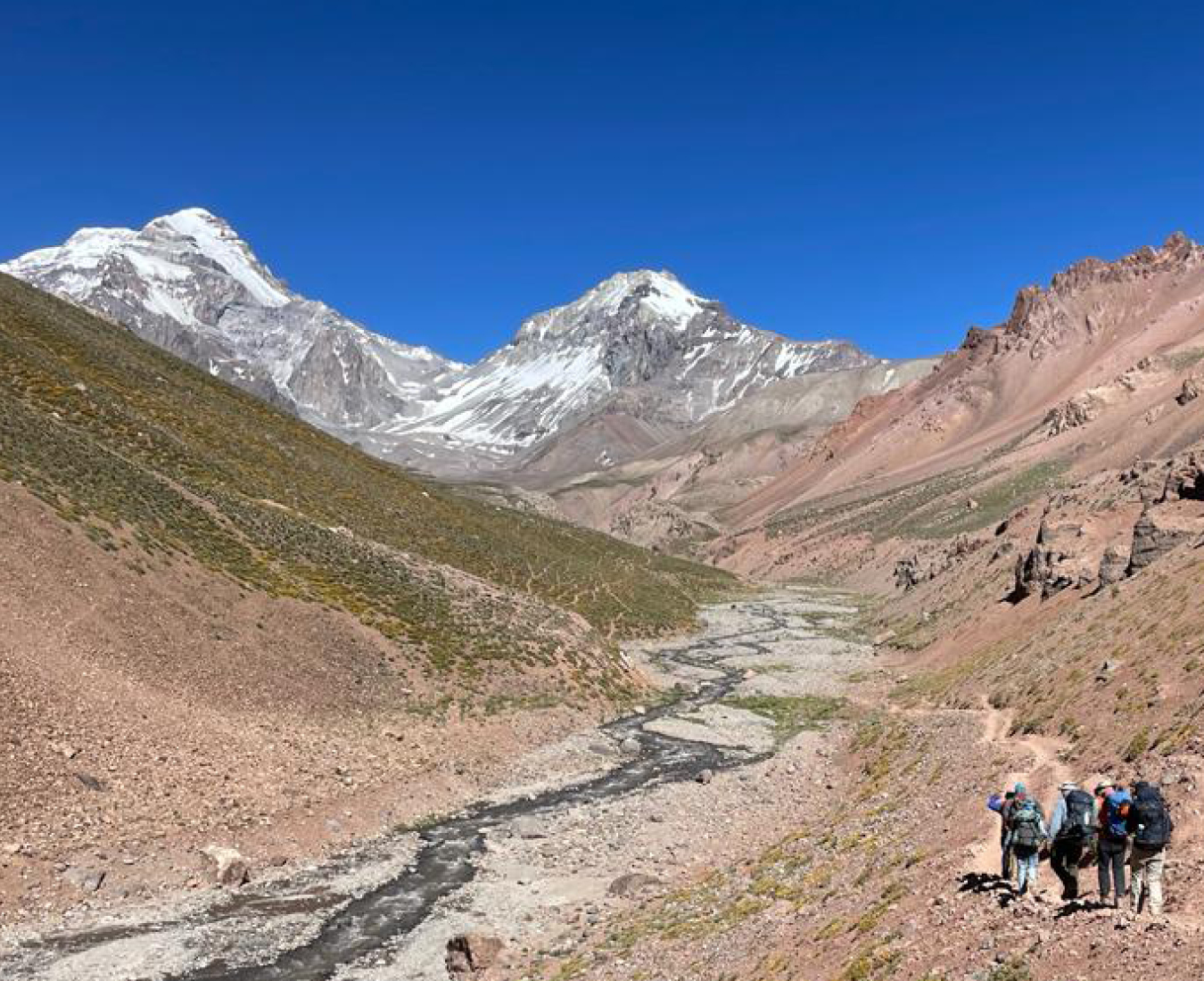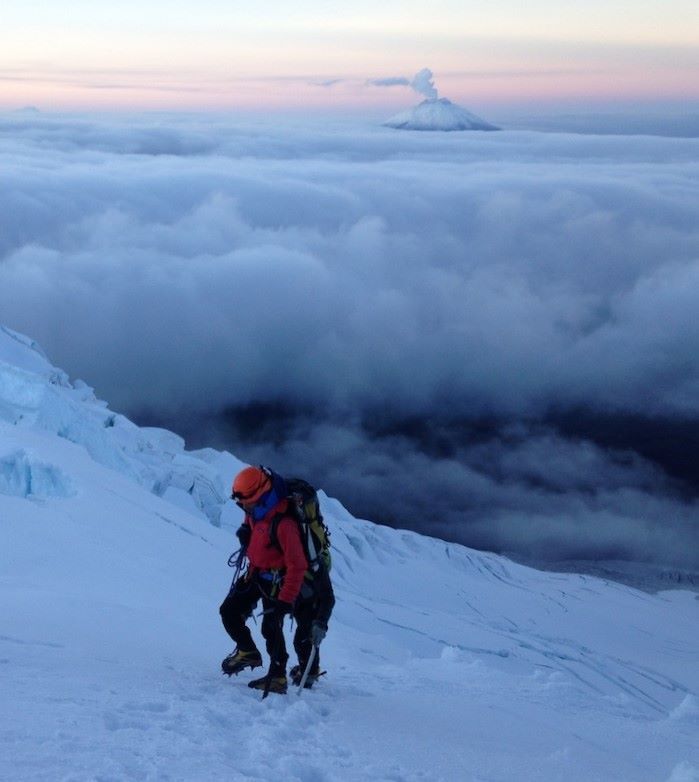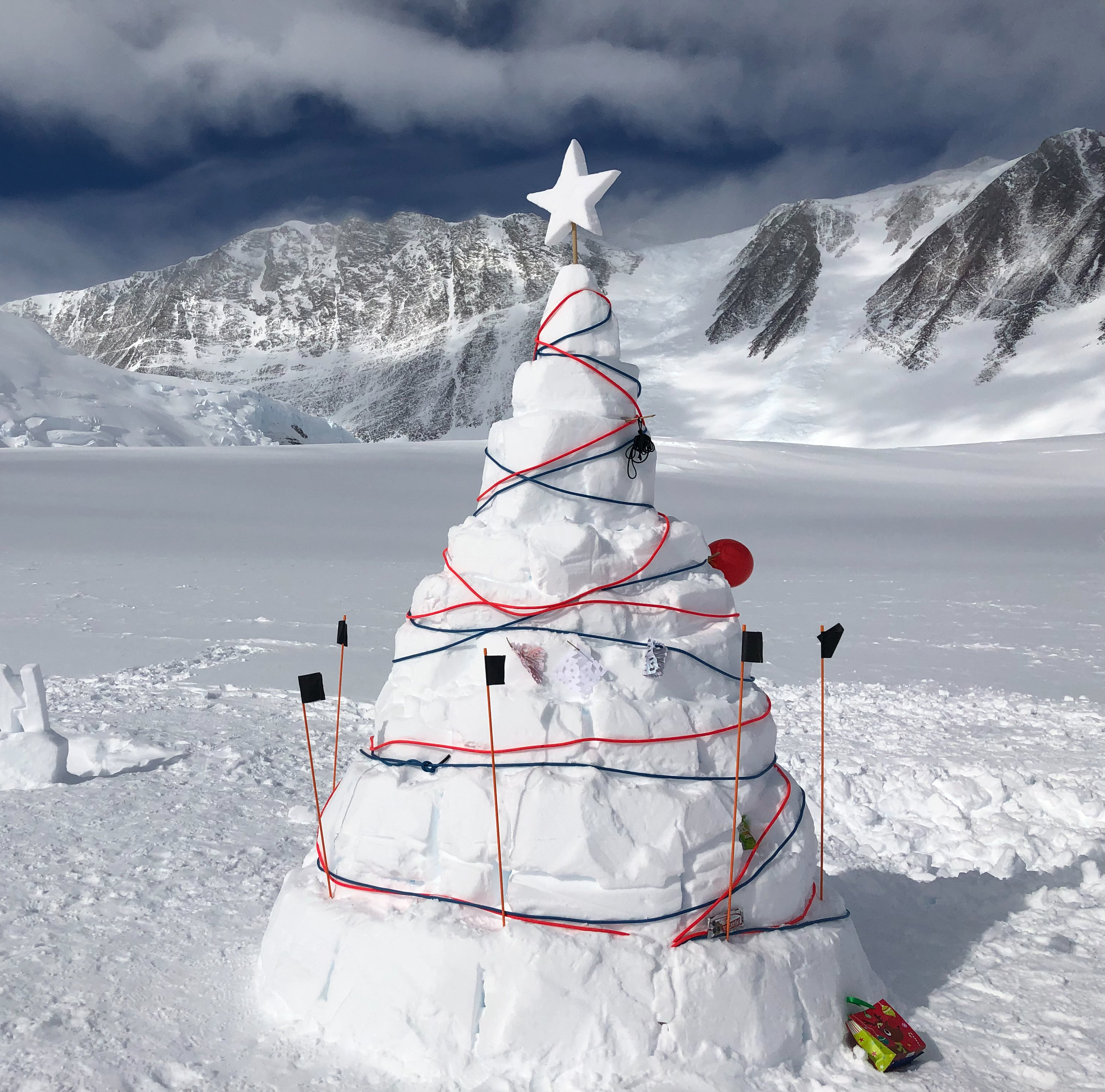A very high level of aerobic fitness is required for Aoraki Mount Cook. You must be able to climb 1,000 vertical metres with an 8 kg backpack in 3.5 hours or less.
The spectacular peaks of the Aoraki Mount Cook region have attracted climbers from all over the world since the 1890s. Climbing Aoraki Mount Cook (NZ's highest peak - 3,724 metres) is a long, physically demanding challenge for experienced mountaineers.
Aoraki Mount Cook is a serious mountaineering objective. It is often underestimated because of its relatively low elevation. The vertical relief, degree of glaciation, and robust weather of the region create a very serious mountaineering challenge.
The level of commitment required by the guide and guest cannot be overstated. A guided ascent of Aoraki is only available to returning guests who meet our prerequisite criteria.
All bookings for Aoraki Mount Cook are made on a request basis, after consideration of previous experience. There are no set departures. Please use the contact form here or get in touch directly to discuss the options available.
Climbing Ability
Climbing Ability
Advanced
Elevation
Elevation
3,742m/12,276
Duration
Duration
6 days
Location
Location
Aoraki Mount Cook, NZ
Meet your guide in Aoraki Mount Cook Village. Check gear and fly into the mountains to Plateau Hut in the early afternoon.
Acclimatisation day. Consolidate skills or ascend a practice peak such as Mount Dixon. |
Summit day, start 1am, and finish 7pm! OR climb part of the route then bivvy out overnight.
Second day of the climb, rest day, contingency day or fly out on a back flight to Mount Cook Airport.
Weather contingency day or optional alternate activity.
Weather contingency day or optional alternate activity.

Departures and Pricing
| Start/End | Departing from | Quantity | Pricing | Notes | Book |
|---|---|---|---|---|---|
| Oct - Dec 2026 | Aoraki Mount Cook Village, New Zealand | Available | $11,500 NZD $ | ||
Need more training before attempting Aoraki? Check out our classic Technical Mountaineering Course
PREPARE
A successful ascent of Aoraki requires proven climbing proficiency, excellent physical fitness, and recent alpine experience. Only return guests are accepted.
- Currency - at least 14 days on crampons within the last 2 years
- Proven experience climbing with 2 tools on 45 to 50 degrees snow and ice
- Proven experience of several 12+ hour days on alpine ascents (NZ alpine 2+) or equivalent - within the last 2 years
- Glacier travel experience and the ability to competently demonstrate a crevasse rescue system
- Rock climbing competence - climbing to Australian 14/US 5.7
Mountaineering on the Aoraki Mount Cook massif is a hazardous activity. Although technically the “easiest” route on Aoraki Mount Cook, the Linda Glacier has a relatively high level of objective hazard (a natural hazard that we cannot control, only minimise). The route is exposed in numerous places to avalanches, rockfall, and ice-fall danger from above.
It is essential that your fitness, ability, and conditions allow you and your guide to move quickly through these hazardous zones.
The guide’s primary concern is always for safety. Your guide’s appraisal of your competence and route conditions will determine whether the climb can be attempted, or an alternative ascent is considered instead.
From December onwards, the route can become heavily crevassed, before eventually becoming impassable. Crevassing may slow travel through areas threatened by ice avalanches, and can be unacceptable from a safe guiding perspective.
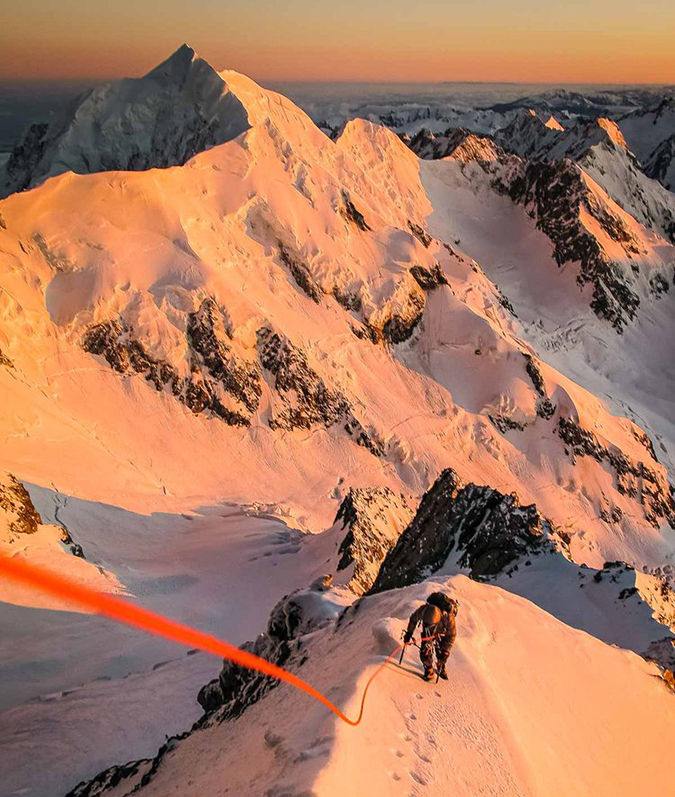
The Adventure Consultants story evolved from the Southern Alps of New Zealand where large glaciated mountains forged our passion for high places. It is a legacy that still exists today through guided ascents and instruction programs. We work with the best guides in the country to bring you high-quality programs that introduce you to the best the country has to offer and we regularly partner with Alpine Guides (Aoraki) to provide professional guiding under the IFMGA qualification program.
The price of your trip includes the following:
- Professional NZMGA/IFMGA mountain guide on a 1:1 basis
- All meals and snacks from lunch on day one to lunch on day 6
- Aircraft flights in and out of Plateau Hut
- Hut fees and National Park fees
- Local transport
- Accommodation in Mount Cook Village (if required)
- Technical equipment.

Aoraki Mount Cook holds a special spiritual significance for the New Zealand Māori, and the Ngāi Tahu iwi in particular, who consider the mountain to be an ancestor, and therefore sacred.
Alpine Guides respects the wishes of Ngāi Tahu and we will not guide our clients to the absolute summit of Aoraki, but stop a few steps from this point. This is in fact the highest safe point on the mountain.
On December 14, 1991, the High Peak of Aoraki dramatically collapsed, taking about 10 vertical metres, and millions of tonnes of rock and ice, down the East Face. The transformed peak is now an exposed and unstable ice arête.
Read about the significance of Aoraki to Ngāi Tahu. The Kāti Huirapa and Arowhenua people assume responsibility as kaitiaki - guardians to Aoraki Mount Cook and the surrounding areas.
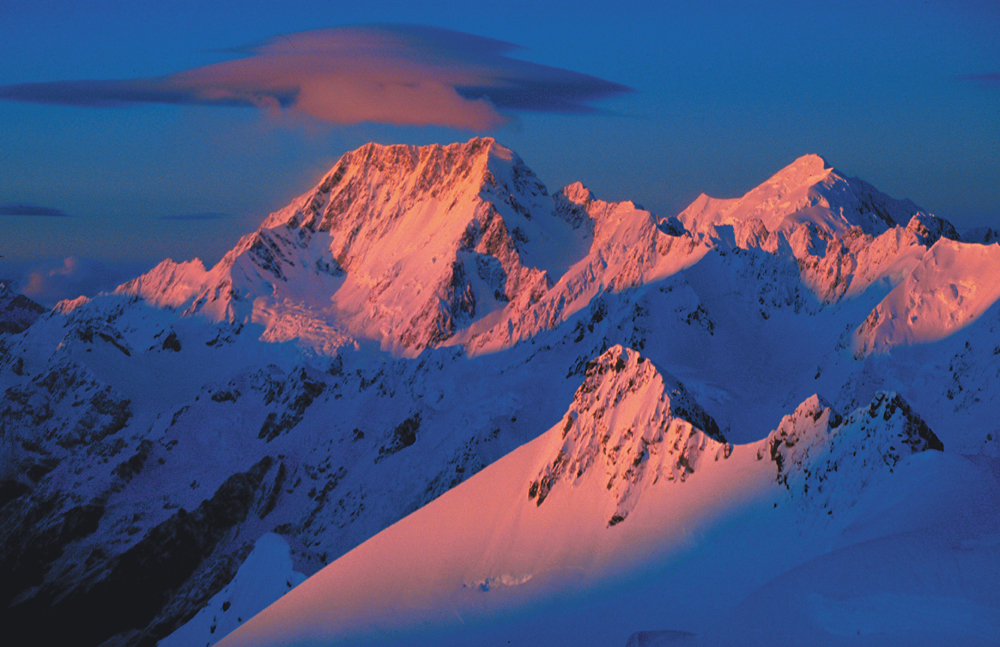
Kia tuohu kotou, Me he maunga teitei, Ko Aoraki anake.
If you must bow your head then let it be to the lofty mountain Aoraki.
The climbing season on Aoraki Mount Cook is short, running from late October to late December.
The affects of climate change are evident on our mountains and have reduced the length of the climbing season for Aoraki Mount Cook over the past 3 decades. Although it may be possible to attempt Aoraki Mount Cook later in the season (every year is different), we will only accept bookings that finish before late-December (pre-Christmas).
Early Season: October through mid-November
The possibility of soft snow (slowing travel), and heightened avalanche risk are the major constraints of an early-season expedition. A climb may be possible, but will be subject to your guide’s interpretation of the hazard level. For early-season trips, it can be very helpful if you are proficient with either snowshoes or ski touring/split-board equipment.
December Onwards
Route conditions on parts of the Linda Glacier will deteriorate as summer progresses. There will be periods through summer where the degree of crevassing, and ice-cliff activity, makes the route too hazardous (in our opinion) to guide. Good conditions may extend the climbing season.
We always take a conservative approach to this increased risk.
The most commonly guided route is the Linda Glacier and North-East Ridge from Plateau Hut. This is a long and serious climb, usually taking 15-18 hours, return. The height gain is approximately 1,700m/5,500 ft from Plateau Hut.
Probably around 80% of all ascents (and 90% of descents), both guided and recreational, use the Linda Glacier route. The Linda Glacier is the most straightforward route and offers the best chance to reach the high peak. The Linda Glacier route is always challenging, and not to be underestimated.
The Linda Glacier is relatively low-angled. Up to the Linda Shelf, there is an objective hazard from ice cliffs on Mt Silberhorn and rockfall off Mount Vancouver. A steady and efficient pace must be maintained to minimise risk.
To reach the Linda Shelf the “Gun Barrels” must be traversed, and on the shelf itself, the “Mini Gun Barrels” crossed. Both areas are subject to danger from falling ice debris. Steady, rapid movement is required in these places.
You will normally be moving together with your guide until the Linda Shelf steepens. The last 50 to 100 metres is pitched climbing, on 40° to 45° ice up to the base of the Summit Rocks. We try to be at this point just after dawn.
The Summit Rocks are normally iced up but can be a rock climbed in the mid-late season, or in dry conditions. Three or 4 pitches are belayed to the summit ice cap.
Conditions on the ice cap vary, from soft snow/ice to solid “boilerplate” ice. This section to the summit can be time-consuming, and always requires concentration and care. Usually, it is only necessary to belay short sections.
After 8-10 hours of climbing the view is indescribable, stretching for hundreds of kilometres up and down the Alps, to the Tasman Sea and the Pacific Ocean.
The descent (by the same route) usually takes 7-10 hours. The descent requires concentration and good crampon technique down the ice cap. Your guide will lower you through the Summit Rocks.
Speed through the Gun Barrel section is essential, as warmer temperatures will soften the snow, increasing the risk of avalanches and rockfall.
Mountaineering proficiency is only gained experientially - by practice. Being physically fit and determined are necessary qualities for climbers, but only extensive crampon “mileage” in serious glaciated terrain will provide the necessary training for a safe ascent.
If you have Aoraki as a potential future goal (or any other serious glaciated mountain), there are plenty of ways to gain experience. Depending on your existing experience, we are happy to advise a suitable strategy.
The essentials are:
- A solid grounding in the basics. Start with a comprehensive instruction course - for example, the Alpine Skills Course (ASC) - to give you the base competencies. Something to build on. Alternatively, come with a friend, and we can build a Private Instruction course for you.
- Development. Build your experience on other peaks. Follow up a course with an Ascents Program, a Mount Aspiring Expedition, or a Technical Mountaineering Course (TMC). Climb with a friend or join a club (the NZ Alpine Club, for example) to gain the required mileage.
During any training with Alpine Guides, your guide will advise you on potentially suitable follow-up objectives, or specific areas of training to work on, and if they think you are ready for the challenge.
Take Your Time With Training
We recommend taking your time to develop your skills over at least 2 or 3 climbing seasons. We see a tendency for goal-oriented people to try to compress training and experience development into one season. However, in reality, this is rarely a successful strategy.
Common Guest Issues we Experience
Outside of weather and route conditions (which we cannot control), here are some reasons why some guests have struggled on Aoraki Mount Cook.
Our recommendations around training and experience attempt to mitigate these issues, and allow for the best chance for a summit attempt.
- Lack of mountain fitness. Mountain fitness is developed over time, with long days carrying moderate loads. High cardiovascular fitness is important, but cycling and running do not provide the same kind of conditioning as climbing.
- Not appreciating the scale of terrain and risk involved. Feeling overwhelmed and not able to deal with the degree of exposure.
- Unfamiliarity with the dynamics of local weather and conditions. Conditions can be extremely variable, even over the space of a day; from boiler-plate ice to soft post-hole snow. Experience with exposure to a range of climbing conditions is vital.
We use aircraft for access to and egress from the Grand Plateau. A climb to Plateau Hut is a strenuous exercise of 1.5 days. The route options are limited to 2 difficult climbs that can only be attempted in good weather.
Flying in makes the best use of available good weather. Because this does not allow your guide to determine your fitness, a “training” climb (the Anzac Peaks, for example) may be attempted before Aoraki Mount Cook. This is at your guide’s discretion and ensures our standards of safety are maintained.
These special conditions are in addition to our standard booking terms and conditions:
- A period of 6 days is covered in the cost. If you achieve the summit earlier, you have the option of retaining your guide and completing another climb or returning to Aoraki Mount Cook village. Additional climbing will be at the discretion of the guide, based on your ability and the prevailing conditions. No refund is due if you choose to finish early.
- Extensions to the package may be possible (depending on your guide’s work commitments) — this will be an additional cost of NZ$995 per day, which includes food and hut fees. You can select this when booking.
- If the period is involuntarily extended (for example being held at Plateau Hut by a storm), the cost is an additional NZ$795 per day.
- It is not possible to cancel your booking for a refund due to changing route conditions. An alternative objective will be proposed. All itineraries are subject to change around weather and mountain conditions.
Once you have made your booking we strongly advise buying travel insurance, to cover you for unexpected cancellations, or other misadventures on your travels.
Travel insurance cancellation policies will protect you from losing the deposit for your trip if you have to cancel unexpectedly.
Insurance specifically for mountaineering activities is optional. New Zealand's Accident Compensation Corporation (ACC) system extends to all visitors to New Zealand and includes cover in the event of an accident.
Any travel agent, or insurance broker (even your credit card provider) can assist with standard insurance, including insurance for trip cancellation.
The New Zealand Alpine Club can provide insurance coverage for their New Zealand and Australian members visiting NZ.





